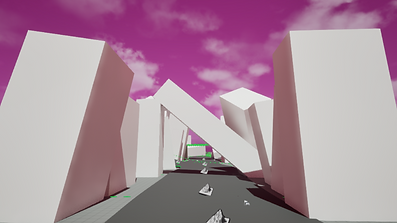Level Design
My process: When designing a level, I like to start by thinking about what feelings we are trying to convey to the player. Do we want them to feel empowered? Small? Anxious? In awe?
I also take into consideration what we want the player to be doing in the level, and whether we want to guide them to a specific area or do we want them to explore themselves.
Papermaps and Concept

Rough papermap level of a more linear level with landmarks denoted by text and colours.

Rough papermap level of an open-world level with landmarks denoted by numbers. Numbers used to annotate the map and document further.

Paper map of an individual room, hexagonal in shape to communicate symmetry, structure, and ritual. This is broken only by a fallen tree and pillar, which obscure the player's path (orange area). Yellow arrows indicate the direction of light path which will cast long shadows into the room, encouraging the player to follow the path (grey arrow) to the exit.
The central hexagon shape represents a large monument which forces the player to physically angle the camera upwards, making the player feel smaller in the room. Large windows (blue) and murals on the walls (purple) will prompt the player to explore the room as they navigate to the exit.
Blockout

Blockout level of a side-scrolling game. Level includes, death pits, jumping platforms and ramps to dash up.
Blockout level of a racing-game, using landscape splines to shape the track and cubes to block out structural assets.


Another block out of temple ruins using various shapes and angles to convey different feelings.




Environmental Storytelling
Grief: A room that was once a full banquet hall where people gathered for communal events, is now empty. Memories of the hall are communicated through placement of the tables and chairs, as well as their relation to the stage area at the far end of the room.
Pink boxes indicate environmental markers that add to the narrative (i.e; a stack of playing cards and half-finished drinks communicate that people at this table were playing cards. A single drawn out chair shows that someone stepped away from the table momentarily).
The player is gently encouraged to explore the room by way of having to weave through the tables and chairs to get to the exit, which is illuminated by sunlight cascading through the open doorway.
Large imagery on the walls (murals and paintings) depict what the room used to look like (full of laughter, love, and community), offering a stark contrast to what the room is now: empty and lacking life. These murals are placed on the opposite side of the room from the player's entrance, causing them to be the first thing the player sees upon stepping into the room.
High windows are placed on both sides of the room, but light is primarily obscured by floral. The absence of natural light, paired with these windows, offers a contradiction to the player and a sense of unease.
